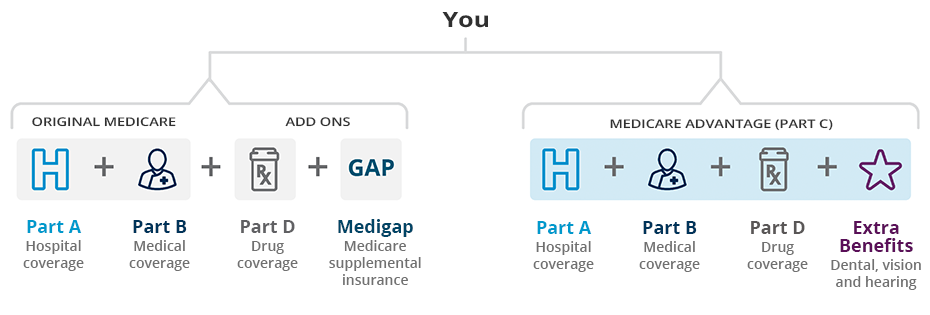What is Medicare?
Get to know the basics, so you can make good decisions for your health and budget.
Medicare is Personal Health Insurance
Medicare doesn’t cover your spouse or children, only you.
It’s for people 65 or older, younger people with certain disabilities, and people of any age with end-stage renal disease or Amyotrophic Lateral Sclerosis (ALS).
To get Medicare, you must be:
- A United States citizen, or
- A legal resident who’s lived in the country for at least 5 years


Medicare has Different Parts
- Medicare Part A – Covers hospital visits
- Medicare Part B – Covers doctor visits
- Medicare Part C – Medicare Advantage
- Medicare Part D – Covers prescription drugs
- Medicare Supplement (Medigap) – Helps you cover out-of-pocket costs

Medicare Part A and Part B are administered by the federal government. These two parts are known as Original Medicare.
Part C, Part D and Medical Supplement plans are available from private healthcare companies like CareFirst BlueCross BlueShield.
How Can I Save on Medicare Costs?
To save on healthcare expenses, it’s important to visit doctors, hospitals and healthcare facilities that accept Medicare.
Participating Providers
These are doctors, specialists and primary care physicians who accept Medicare and always accept the full payment of a Medicare-approved amount for health services.
Non-Participating Providers
These are doctors who accept Medicare. However, they DO NOT accept the full payment. These providers can charge up to 15% more than the Medicare-approved amount.
Opt-Out Providers
These are doctors who do not accept Medicare at all. You will be responsible for 100% of the bill.
LEARN
Get to know the different parts of Medicare—Part A, B, C, D and Medicare Supplement.
EXPLORE
See how the different parts of Medicare can be combined to create a plan that fits your needs.
PREPARE
Knowing when to enroll in Medicare is important because it can save you money.
Explore More of the Basics
There are programs available that can help you cover the costs of your medical expenses. Program include:
- Medicaid
- Medicare Savings Program
- Extra Help (Part D prescription drug coverage)
Yes. It’s called dual eligibility.
Medicare pays your doctors first. Then, Medicaid pays the remaining expenses. This often covers most of your total health care cost.
Dual coverage often offers benefits not covered by Parts A and B, including dental, hearing and vision.
For more information, contact your state’s Medicaid office. Or, call Social Security toll-free at 800-772-1213, TYY 800-325-0078.
Explore Medicare Further
At CareFirst BlueCross BlueShield, we’re committed to helping you learn the basics of Medicare. After all, your health is everything. And getting the coverage you need to live your healthiest life is essential. That starts with understanding.
Here are some additional resources for more assistance and information on Medicare.
- Medicare: medicare.gov
- The Centers for Medicare & Medicaid Services: cms.gov
- Social Security Administration: ssa.gov
- U.S. Department of Health & Human Services: hhs.gov
- State Health Insurance Assistance Program (SHIP): SHIP website
- Medicaid: medicaid.gov
- Call Medicare 24/7: 800-633-4227 or (TYY) 877-486-2048
